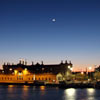
For Spring Break in 2007, Megan and I took a trip to Barcelona and Madrid. I had been to both cities about five years earlier, the summer after I graduated highschool, but it was Megan's first time in Europe (other than an airport).
La Rambla and Bari Gotic
Barcelona is a fantasitc city. It has incredible character and beauty. La Rambla, the main pedestrian artery of the city is full of street performers, bird and flower venders, tourist trap shops, and outdoor seating areas for countless cafes and restaurants where you can stop to enjoy some sangria and perhaps some paella. We stayed in a hostel in a perfect spot, right at the top of La Rambla, and each morning visited the Santa Catarina Market to get some fresh bread and fruit.
Off to the east lies the Bari Gotic, the old quarter where winding streets invariably lead you back to the city's main cathedral. We toured the cathedral as well as the nearby City History museum, which traces Barcelona's roots back to the Roman ruins now burried under the city.
Gaudi's Sagrada Familia
Barcelona is an incredible city for architecture, and La Sagrada Familia, the as yet unfinished church by Anton Gaudi is the grandest example. It is like no other church in the world, and in fact reminds me more of an alien space ship.
A lot of work remains to be done inside the church, but the vaulted ceiling is already a sight to behold with its patterns of gold. The stained glass is also quite beautiful and fills the halls with a colorful glow. In some ways it is kind of nice that the walls aren't all finished as the interior is bright and sunny as opposed to the dark slightly oppressing nature of many cathedrals.
There are currently four towers on each end, but a total of 18 are in the plans. A grand central spire will rise 170 meters--one meter shorter than the hill Montjuic which overlooks the city--since Gaudi did not believe his work "should suprass that of God".
Park Guell
Gaudi was hired to build this park as a development full of fancy, expensive houses. Fortunately for the rest of us, the business plan fell through, and the city bought the land and made it into a public park. Before they ran out of money, Gaudi built a few buildings (conveniently including the one he lived in), as well as some elaborate sitting areas and paths.
We enjoyed a nice picnic lunch of Manchego cheese and Iberico ham sandwhiches. Later, the beautiful blue skies filled with clouds and it began to rain. Luckily, we were able to escape to the Gaudi museum to stay dry. The museum is in his house and is mostly interesting for the antique furniture, much of it designed by Gaudi himself.
Gaudi was greatly inspired by nature, and the shapes of the park's gatehouses and terraces fit well with Barcelona's costal position. I can almost imagine a giant hermit crab like creature peaking out of the arched doorways.
More Modernisme and the Waterfront
Throughout Barcelona are other examples of the Modernisme architecture school which Gaudi started, such as the buildings along La Manzana de la Discorda or "block of discord". Gaudi's building there tells the story of Sir George and the Dragon, thus the sinuous, scaled rooftop.
Barcelona is also a coastal city, so we spent some time in the waterfront at the foot of La Rambla. There Columbus stands, pointing off towards the new world (actually it is closer to behind him). There isn't too much there other than a mall and some docks, unfortunately we missed the night market.
In Barcelona we had some paella on La Rambla (not too great) and ate at Taller de Tapas which was quite delicious. We sampled dishes from patatas bravas to baby squid, and the wine was also excellent. My mouth waters at the thought.
























